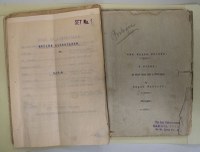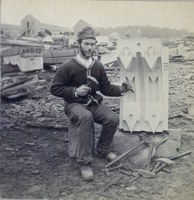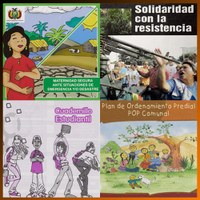> See 2008 Projects | 2009 Projects | 2010 Projects | 2011 Projects | 2012 Projects | 2013 Projects | 2014 Projects
The following twenty-two projects were selected from among seventy-five proposals submitted in 2013. Award recipients will create web-accessible records according to standards that will enable the federation of their local cataloging entries into larger groups of related records, enabling the broadest possible exposure to the scholarly community.
 Amherst College
Amherst College
Samuel French Theatre Archives
$144,300
This two-year project will make the Samuel French Theatre Archives available to scholars. This collection is rich in correspondence with playwrights and producers in the United States and England. Business correspondence reflects the company’s interest in and influence on international copyright law. The company pioneered the business of marketing scripts and supporting material to encourage productions by amateur theatre groups, in addition to their work with professional theatres in major cities. The business records include information on productions of plays published by Samuel French throughout the United States and the process by which European plays were acquired and adapted for American audiences. Scrapbooks of newspaper clippings, publicity photos, playbills, tickets, and other ephemera document both professional and amateur productions. Manuscripts and typescript drafts of both music and scripts are another major component of the collection that will be of enormous interest to students and scholars.
 Bok Tower Gardens
Bok Tower Gardens
Cataloging the Vertical Files of the Anton Brees Carillon Library
$219,700
The Anton Brees Carillon Library at Bok Tower Gardens contains items related to carillons and the professionals that play them. Over the course of three years, the ABCL vertical files, including the archive of the Guild of Carillonneurs in North America, will be cataloged. The files contain concert programs, PR materials, postcards, photographs, books, slides, carillon recordings, newspaper clippings, souvenirs, and biographical information. These materials tell the story of the development of carillon art in North America and how it continues to be linked with its European roots. No other collection of carillon related materials has such an inclusive scope and discovery of these items is vital for comprehensive study of the field.
California Academy of Sciences
Frontier Science: Providing Access to the Early Scientific History of the American West in the Collections of the California Academy of Sciences
$50,600
The Archives at the California Academy of Sciences document the founding of the Academy, the development of the American West, and the advancement of natural sciences throughout the latter half of the 19th century. The Archives aims to expose ten previously undescribed, pre-1906 collections, and to create new connections between these collections and potential users by implementing the use of linked Dublin Core records to create dynamic, web-based finding aids. The resultant metadata will be both compatible with EAD and shareable across social media networks at the component level, encouraging new users to explore the archival context of collection materials and increasing discoverability at the file- and item-level.
 Columbia University
Columbia University
Makino Collection Film Ephemera and Rare Book Project
$380,500
The Makino Mamoru Collection contains over 80,000 items chronicling the history of Japanese and East Asian film from the earliest moving pictures in Japan through 2006. While archival processing at Columbia has begun, significant sections require additional staff and specialized knowledge to reveal them. This includes original cataloging and archiving of rare books, early film magazines, internal film studio documents, film programs, and ephemera, a significant portion of which are unavailable in the U.S. or Japan. Processing these items with MARC records and an online finding aid that includes Japanese characters will enable scholars to access these unique materials independently, impacting various scholarly fields globally.
 Dayton Society of Natural History
Dayton Society of Natural History
The Lichliter Site Project: A Model for Revealing Hidden Archaeological Collections
$91,000
The project goal is to catalog artifacts from the prehistoric Lichliter site, one of the most significant archaeological sites in the Ohio River Valley. Despite a lengthy excavation and broad scholarly interest, the information recovered from this site has been “hidden” for half a century. Cataloging will be undertaken with ArcheoLink software, widely used in Europe, to allow all data from the site to be cross-referenced in an integrated database. The project will result in two products: the wide availability of data pertaining to a cultural period of national significance, and the application of the ArcheoLink model to a North American dataset illustrating an efficient approach for cataloging archaeological research collections.
 Erie Canal Museum
Erie Canal Museum
Canal Society of New York State Collection
$71,100
The Erie Canal Museum (ECM), the Canal Society of New York State (CSNYS) and the Canadian Canal Society (CCS) are joining to uncover what has been lost to scholarship for decades. The CSNYS’s 600 cubic feet of manuscripts, photographs and other artifacts have been inaccessible until 2012 when the ECM welcomed it as part of a general integration of the two organizations. With much still in shipping boxes and little remaining intellectual control, it nonetheless has unique resources for the transportation and social histories of the US and Canada. The one-year proposal is to reestablish physical order, provide initial online access to the estimated 150 collections and develop a pilot for an item-level online database of the historic images.
 George Eastman House
George Eastman House
Documenting Their Films: Hidden Collections of Four Independent Filmmakers
$155,900
This project will create finding aids for the manuscript collections of four independent filmmakers – Leo Hurwitz, Lothar Wolff, Douglass Crockwell, and James Reese – whose film collections are housed in the Moving Image Department. The collections provide a wealth of primary source material for scholars of documentary, experimental, avant-garde, and industrial films. Finding aids that address each collection in its entirety, that can be shared online and upon request, will increase awareness of these collections, facilitate quicker access to the materials, and maximize staff efficiency.
The George Washington University
D.C. Africana Archives Project (DCAAP)
$495,900
The George Washington University Libraries’ Special Collections Research Center will partner with the District of Columbia Archives, Howard University’s Moorland-Spingarn Research Center, the Historical Society of Washington, DC, the National Museum of American History’s Archives Center, and the Martin Luther King Jr. Memorial Library to significantly enhance access to 125- 150 Africana archival collections. Washington, DC boasts many impressive Africana history collections, but a large number of them are unprocessed or lack adequate cataloging, making them difficult to access or use. Over 33 months, this project will improve cataloging, arrangement and description, and create a centralized database for researchers to access EAD finding aids.
 Hagley Museum and Library
Hagley Museum and Library
The David Sarnoff Collection Processing Project
$291,500
This project will make available in three years full public access to the David Sarnoff Collection, the extraordinary and comprehensive 2,800-linear-foot archive of materials documenting the business dealings of David Sarnoff, pioneer of the media and electronics age. The history of the Radio Corporation of America (RCA) and the founding of the National Broadcasting Company (NBC) are recorded in the collection’s manuscripts, reports, notebooks, publications, photographs, moving images, and sound recordings. RCA’s research and development activities as well as the emerging American consumer culture are also recorded here. About 110 feet have been processed, but present methods indicate 14 years to process the collection.
Kansas City Public Library
The Kansas City Stockyards Collection
$101,000
Kansas City’s “cowtown” origins and agribusiness development came to be defined by the Kansas City Stockyards. The archives of this significant, iconic business, which have always been completely hidden from researchers, will be catalogued and made accessible to researchers and the public by the Missouri Valley Special Collections of The Kansas City Public Library.
La MaMa Experimental Theatre Club
Cataloging La MaMa’s Pushcart Years: A Unique History of the Off-Off Broadway Theatre Movement
$135,100
The La MaMa Archive is a valuable educational and historic resource that chronicles the evolution of La MaMa from a basement theatre to a world-renowned arts organization. The La MaMa Archive chronicles an important American legacy-the artists, companies, and historic productions that found a home at La MaMa and have had a lasting influence on the performing arts landscape in this country. Of particular importance are the early years of the organization-headed by Ellen Stewart-and its unique vision for an alternative performance venue open to experimentation.
Lehigh University
Bridge and Building Forensics: Civil Engineering Archives at Lehigh University
$93,700
The Lehigh University Libraries Special Collections will process and create finding aids for six civil engineering archival collections, including the papers of John Fisher; Blair Birdsall; Willis Slater; and the Council on Tall Buildings and Urban Habitat. In addition, a collection of postcards depicting American bridges and a series of photographs showing laboratory testing will be described in this two-year project.
 Maine State Museum
Maine State Museum
An American Mirror: Early Photograph Collections at the Maine State Museum
$145,600
This project is a pioneering three-year collaboration between the Maine State Museum and the Maine Historic Preservation Commission, independent agencies, to catalogue and put on-line 15,000 stereoviews (1858-1895) and 6,000 photo postcards (1900-1952). The collection is the most important of its kind in Maine and the stereoviews are the most important collection of their type in the United States; the collection has national and even international significance. The well-documented images provide an unmatched reflection of all aspects of American life, essentially unavailable for lack of cataloguing or publicized access. Informative public and institutional activities are included.
 The Newberry Library
The Newberry Library
Printing Specimens (1605-present) at the Newberry Library
$216,100
The Newberry’s John M. Wing Foundation on the History of Printing has one of the world’s oldest and largest specialized collections on book arts and printing history. This project will provide access to a large backlog of primary source materials dating from 1605 to the present, both books and ephemera, which serve as specimens of printing in every period. Melding both archival and cataloging approaches in a single project, it is an excellent opportunity to develop a model which will be employed for other collections at the Newberry, and can be emulated by others. The nearly 30,000 items of print specimens and ephemera will be described via collection-level catalog records and archival finding aids, using FAST (Faceted Application of Subject Terminology) subject headings. The archival inventories will be made available to a wide range of scholars on the Newberry’s website, and ArchiveGrid, allowing researchers to search inventories by subject, name, and keyword. Social media will further lead potential users to these sources, and collaboration with design educators and humanities scholars will broaden awareness of the Collection’s value for research and teaching. For additional information, see http://www.newberry.org/hidden-collection-comes-light.
 Princeton University
Princeton University
Princeton University Library’s Latin American Ephemera Project
$199,800
Princeton University Library (PUL) will take an innovative approach for efficiently creating item-level metadata for a vast and completely hidden collection of digitized ephemeral materials from Latin America. The proposed cataloging project is an essential step in the larger process of making the images of digitally reformatted ephemera freely, globally available through a discovery interface which includes faceted searching and browsing. In addition to creation of thousands of new records, outcomes of the 3-year project include development and deployment of a scalable, sustainable and replicable model for timely online disclosure of similar hidden collections, and broad potential for new collaborative initiatives for shared access.
San Diego Museum of Man
Cataloging Hidden Collections: San Diego Museum of Man’s Archaeology, Archival and Photographic Collections
$240,500
The role of museums has been to collect and safeguard humanity’s cultural heritage. These often hidden artifacts and research data have traditionally been available only to a few privileged academics. Tribal scholars in particular, have not been given the same level of access to their cultural heritage as their non-native counterparts. The San Diego Museum of Man intends to provide academics and Native American scholars unprecedented access by cataloging 32,000 archaeology, archival, and photographic records relevant to San Diego, collected between the 1900s and the 1990s. In collaboration with local archaeological centers, this three-year project will enhance scholarship and be a replicable model nationwide for data-sharing.
 Union College
Union College
Grass Roots Activism and the American Wilderness: Pioneers in the Twentieth Century Adirondack Park Conservation Movement
$164,600
This eighteen-month project will provide access via a dedicated website to the collections of John S. Apperson and Paul Schaefer, lifelong conservationists and advocates of the Adirondack Park, the largest protected parkland in the contiguous United States. Their papers, dating from 1899–1996 and housed at the Kelly Adirondack Center of Union College, collectively cover 20th Century political activism to conserve the Adirondack Forest Preserve and to expand the Adirondack Park. A patchwork of public and private lands, the Adirondacks are and always have been a peopled wilderness. Apperson’s and Schaefer’s correspondence with conservationists and developers thus reflects the tensions between conserving the land as wilderness and the impact of commercial use, an issue we wrestle with today. The papers also shed light on the important role Adirondack Park activism played in shaping national conservation and wilderness preservation efforts, including the 1964 Wilderness Act. The collections include correspondence, photographs, lantern and 35mm slides, videos, maps, meeting minutes, financial records, publications, and other materials from some 20 advocacy groups formed for specific projects.
 University at Albany, SUNY
University at Albany, SUNY
Building New Access Tools for the National Death Penalty Archive
$119,900
This grant project will create EAD finding aids for ten archival collections held in the National Death Penalty Archive (NDPA) at the University at Albany, SUNY. The NDPA consists of records and papers of leading national figures and organizations who work in the legal, political and educational fields, and documents the contentious legal, political and legislative struggles over capital punishment. The project will arrange, describe and catalog ten NDPA collections totaling 710 cubic feet, including the David Baldus Papers, the National Coalition to Abolish the Death Penalty Records, and Capital Jury Project interviews with over 1,200 jurors from 353 capital trials in 14 states.
 University at Buffalo, SUNY
University at Buffalo, SUNY
Processing the Editorial and Business Records of Eleven Little Literary Magazine Archives in the Poetry Collection
$150,600
The Poetry Collection of the University Libraries, University at Buffalo, the State University of New York, will catalog and make accessible through online EAD finding aids the unprocessed editorial and business records (273 linear feet) contained in the archives of eleven diverse poetry magazines which to date have remained truly hidden and thus not accessible to scholars and graduate students. The eleven magazine archives represent different socio-aesthetic communities of national significance from feminist to academic avant garde to verbo-visual poetry, and access to their editorial and business records will have an immediate impact on scholarship in the fields of post-WWII literary and cultural studies.
 University of North Texas
University of North Texas
Post-War Industry and Development of the Southwest Metroplex
$163,400
This two-year project will create detailed finding aids for eight uncatalogued archival collections at the University of North Texas. By making these descriptions available researchers will have access to materials tracing the development and growth of the largest metropolitan area in the southern United States. Collections proposed for description include papers, maps and photographs documenting the development of DFW airport, the growth of industry in North Texas and the rush to accommodate 4.8 million new residents who came to DFW between 1960 and 2010. Collections document activities at the local, state and national levels and include extensive documentation of the federal Model Cities and Community Development Block Grants programs.
 University of Washington Libraries
University of Washington Libraries
Discovering Modern China: University of Washington and University of British Columbia Collections
$183,500
The University of Washington (UW) & the University of British Columbia (UBC) are collaborating on a joint project to catalog rare and unique hidden Chinese materials making them discoverable throughout the world. Among the top East Asian collections in North America, UW and UBC hold a wealth of hidden Chinese collections including pre-modern classical texts and source materials from the Ming Dynasty (1368-1644) through the early years of the People’s Republic of China (1949-). The pre-modern texts, in a literary form of the Chinese language, are printed in traditional complex characters and bound with string. The 20th century materials include thousands of imprints from the Republic Period (1911-1949). Materials cover subjects in social sciences, literature, humanities and traditional medicine. Cataloging these is a high priority as scholarly interest in China increases.
 Yellowstone Park Foundation
Yellowstone Park Foundation
Using a Team Approach to Expose Yellowstone’s Hidden Collections
$106,000
The Yellowstone National Park Archives are a rich and varied documentation of the natural and cultural resources of the world’s first national park. The archives include manuscripts, photos, maps, films, oral histories, administrative records and scientific data that convey topics ranging from geology and ecology to tourism and history. Because the records are unorganized and poorly described, the collections are hidden to many researchers. Yellowstone proposes using teams to arrange and describe varied records through an innovative “blitz” approach, so that its nationally significant collections are more exposed, accessible and usable. The approach is envisioned as a model for other institutions facing similar archives challenges.

